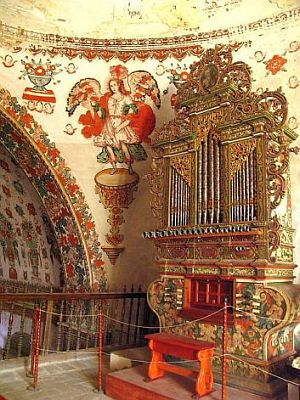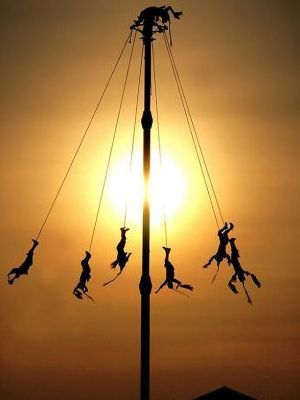Fairs and festivals celebrating everything from saint's days, to animals, to death are a daily fact of life in Mexico. US travelers are familiar with many of them, from Cinco de Mayo to Day of the Dead to seemingly endless Christmas celebrations. But many of Mexico's events are either not well known or are simply unlike anything you'll find in the rest of the world. Here are some of our favorites; there's no point trying to choose one over another, so they are arranged by date.
International Organ and Early Music Festival — Oaxaca (February)
The Festival Internacional de Organo y Musica Antigua honors Oaxacan culture through its historic pipe organs. The Institute of Historic Oaxacan Organs, whose very existence tells you just how important these baroque instruments are in Oaxaca's culture, is coming up on its 10th year hosting the festival in 2013. This year's event, honoring colonial art in Oaxaca's churches, offered concerts on six restored organs, an exhibit of manuscripts related to the historic organs, and a guided tour of the Monte Alban ruins. But the backbone of the festival, as always, was its guided tours of colonial churches in surrounding villages that included eleven unrestored organs, most of them normally off-limits to the public.
 |
| Organ at the Church of San Jerónimo -Tlacochahuaya |
Night of the Witches — Catemaco, Veracruz (March)
Catemaco, on the shore of pretty Lake Catemaco, is witches-and-wizards central, and never more so than on the first Friday of March. Hundreds of shamans, healers, and fortune-tellers from all over Mexico convene on Noche de Brujas to perform a mass cleansing ceremony at a suitably witching hour (it could actually be considered the first Thursday night of March) just outside of town on Cerro Mono Blanco. If you're overdue for a limpia (cleansing) or a tarot reading, this is the time; shamans are believed to be at the height of their powers immediately after their purification ritual.
Tajin Summit — Papantla, Veracruz (March)
This spring equinox festival bursts with concerts by Mexican and international artists, folk dances, Veracruz' unique cuisine, exhibitions, workshops, and a spectacular light and sound show at El Tajín, the archaeological site for which it is named. But Cumbre Tajín is best known for the heart-stopping Danza de los Voladores ("Dance of the Flyers,") an ancient ritual of harmony with nature and the gods most closely associated today with the Totonac people of Veracruz. Four young voladores ("flying men,") one each for the gods of sun, wind, earth, and water, climb a 100-foot pole to a platform where a fifth man plays an invocation to the sun, the four winds, and each of the cardinal directions on flute and drum. The voladores launch themselves off the platform, tethered by their ankles, each circling the pole 13 times as they gradually descend head-first to the ground. Depending on your source, the total of 52 rotations represents either the weeks in a year or the years in one Aztec calendar cycle.
Equinox Celebration — Chichen Itza, Yucatan (March and September)
Especially since Chichen Itza became one of the seven modern Wonders of the World, thousands of people stream to the ancient Maya city to witness El Castillo's spring and fall equinox phenomenon. The angle of the sun as it sets creates a sinuous shadow (from hitting the pyramid's stepped terraces) that "slithers" down the pyramid's northern staircase to meet the gigantic stone serpents' heads at the bottom. Little-known fact No. 1: The effect is visible for a week before and after each equinox. Little-known fact No. 2: Dzibilchaltun, a smaller and much less-visited site north of Merida less than 2 hours away, has its own equinox event. The rising sun shines directly through one window of its main pyramid, the Temple of the Seven Dolls, straight through and out another window, creating a starburst effect.
Sacred Maya Journey — Cozumel (May)
The Travesia Sagrada Maya re-creates the ancient Mayas' pilgrimage by sea from Ppolé (present-day Xcaret Park) to Cutzamil (Cozumel) to pay tribute and hear the prophecies and predictions made at the Oracle of the goddess Ixchel. Canoeists in pre-Hispanic type canoes race the 17 miles from Xcaret to Cozumel. The traditional pilgrimages went on for 700 years until Cortes arrived on Cozumel to plunder (nonexistent) gold before invading mainland Mexico. The tradition was revived in 2007, starting with nighttime ceremonies at Xcaret followed by the launch of thirty 26-foot canoes replicating ancient Maya vessels, bound for the lagoon at Cozumel's Chankanaab National Park. This is a big deal in Maya Mundo; participants train for months before the event. It's a fun deal for visitors, who can join in festivities on either side.
 |
| Danza de los Voladores of Papantla, Veracruz |
Mezcal Fair — Oaxaca (July)
Oaxaca's Guelaguetza, a festival of regional dances from all over the state, is one of Mexico's most famous traditional events. It's probably appropriate that the dancing overshadows the Ferias Nacional del Mezcal, another part of Guelaguetza, much the same way tequila's overpowering popularity outshines mezcal. More than 50 producers from many parts of Mexico are doing their best to reposition mezcal as an important part of local and national culture. We in the United States are only beginning to discover the complexity and variety of tequila, so how could we have known there are more than 100 brands of mezcal? This is the place to learn all about it — recent fairs have not only hosted conferences, mezcal exhibitions, and pairings with Oaxacan cuisine, but re-created a mezcal factory so visitors may witness its creation.
Tepozteco Challenge — Tepoztlan, Morelos (September)
You've got to love the Mexican sense of humor. Tepoztlan, a mountain town and new-age mecca within day-trip distance of Mexico City, was named for the Tepoztecatl, the Aztecs' god of drunkenness and fertility. This was probably inevitable for the son of Mayahuel, goddess of the maguey, and Patecatl, the god who discovered fermentation. So naturally, El Tepozteco, the archaeological site named for him, was a sacred place that drew pilgrims from as far away as Guatemala. Today, Tepoztlan is famous for the Tepozteco pyramid, which remains on a mountain overlooking town, and its Reto al Tepozteco celebrates ... the god-king Tepoztecatl's conversion to Catholicism. A performance depicts his agreeing to be baptized by Spanish conquerors in 1538, intending that his people would follow and be spared suffering at the conquerors' hands. People then join a torch-lit procession to the pyramid to make food and beverage offerings. Chinelo dances dating back to prehispanic times, fireworks and a food festival are part of the fun.
Night of the Radishes — Oaxaca (December)
Christmas in Mexico involves celebrating for weeks on end, but there's nothing quite like Oaxaca's Noche de los Rabanos. Radish-carving appears to have begun as an attempt to lure people to buy produce at the market, but the organized event took hold in 1897. The night of December 23rd, elaborate sculptures created from huge (up to 6.5 pounds) radishes fill stalls around the city's zócalo, taking the form of saints, nativity scenes, famous Mexicans, landmark buildings, flowers, animals, and even the Ballet Folklorico. The local radishes (a Spanish contribution) are cultivated just for this event, left in the ground for months after they mature so they grow to gargantuan size and odd shapes. Thousands of people come for this event, which lasts only a few hours — that's as long as the radishes can withstand the rigors of being employed as folk art.

